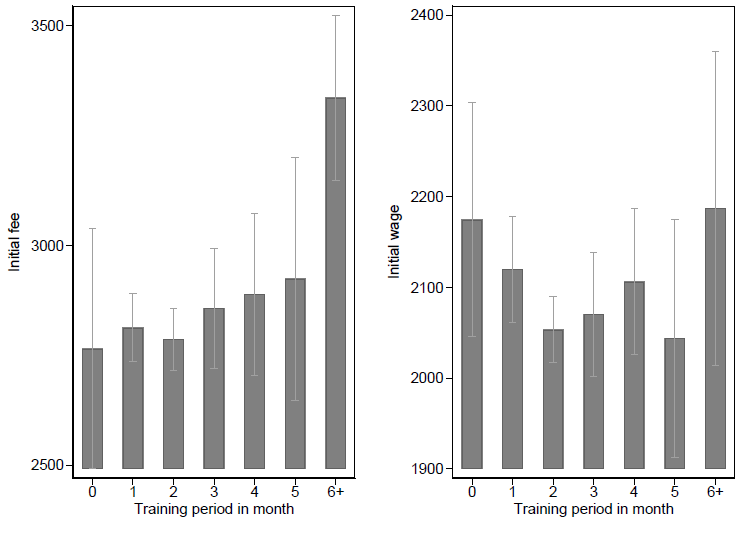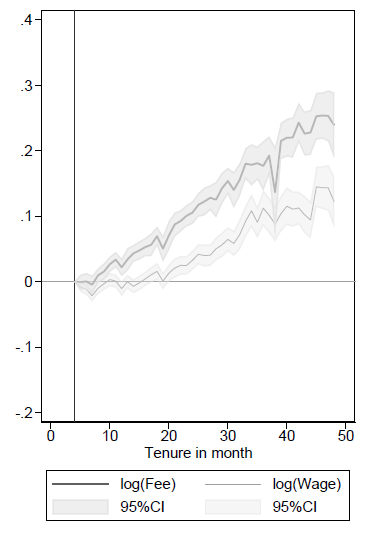Research background and purpose
Who pays for investing in employee skills has been a debated question in labor economics for more than 50 years. It may seem that improving employees’ skills can increase productivity and profits. Still, if employees improve their general-purpose skills, those skills can be used at other companies, encouraging them to change jobs, which reduces investment costs. Gary Becker, winner of the Nobel Prize in economics, pointed out that there is no payback. On the other hand, around 2000, Acemoglu and Pischke theoretically argued that changing jobs in the real labor market is not so easy, and there are frictions. Hence, companies have an opportunity to recover their investment costs.
This argument has become widely accepted in academic circles as being consistent with the reality in countries around the world where companies invest in the skills of their employees at a cost. Still, no rigorous empirical analysis has been conducted. I couldn’t come. In order to verify the theory, it is necessary to show that the productivity improvement realized by skill investment exceeds the wage increase. Still, it is necessary to quantitatively measure the improvement in employee productivity due to skill investment. Because it was difficult. Our research team solved this measurement problem using data from a company that dispatches IT engineers. This data records the fees this company receives from its clients and the wages it pays its employees. So, if you consider the fees it receives from clients as an indicator of employee productivity, the same data contains productivity and wage indicators. This is because it includes both.
This research aims to use this unique data to estimate the impact of skill investment in employees on productivity and wages, and to calculate the rate of return on skill investment from a company’s perspective.
Summary of research results
The companies that received the data are headquartered in the Kanto region, do business nationwide, and dispatch information and communications engineers to client companies. We employ employees from various backgrounds, including new graduates, those with no experience in the industry, and those with industry experience on open-ended contracts. We provide information and communication technology training for approximately two months to develop IT engineers. We are in the business of dispatching people to other countries and receiving a service fee. The content of the training is divided by course, such as a course to acquire the skills necessary to set up and maintain servers. A course to acquire the skills necessary to customize the resource management software used by companies is available. In the case of a server management course, we require employees to take an industry-standard skill certification before completing the training. The skills acquired through this training are general-purpose skills that can be used in various companies.
Using panel data of approximately 2,000 employees from 2015 to 2020 provided by this company, we analyzed how skill investment affects productivity and wages. The results of the analysis are shown in Figure 1, and it is clear that as the training period increases, the fees received from clients increase, but wages do not necessarily increase.

Figure 1 Relationship between the number of months of training, initial assignment hourly rate (left panel), and hourly wage (right panel)
This suggests that while it is possible to increase employee productivity by investing in general-purpose skills, it is not necessary to increase wages. It is also possible that employees’ skills will improve through practical experience when they are assigned to a client company. To clarify this aspect, we also analyzed how rates and wages change as employees gain work experience.

Figure 2 Relationship between the number of months since joining the company, the natural logarithmic value of fees, and the natural logarithmic value of wages
The results of the analysis are shown in Figure 2, where the natural logarithm of the hourly rate increases from the fourth month after joining the company, while the natural logarithm of the hourly wage increases. It became clear that there was no increase for the first 15 months or so. Furthermore, after 15 months, it became clear that the growth rate of fees exceeded the growth rate of wages. This means that while improving skills through practical experience leads to higher hourly rates, it does not lead to an equivalent increase in wages.
The analysis so far has shown that the cost of investing in employee skills is recovered from the difference between fees and wages. Still, it is important to note that employees’ skills are general-purpose. It is also important to keep in mind that many people change jobs to other companies due to this. Analysis of the data shows that four years after joining the company, approximately 40% of the original number of employees remain. Some people quit, which means you may not recover the cost of your skills investment. Therefore, we calculated the expected profit value of an employee by multiplying the probability of the employee remaining with the company by the average price of fees and wages, depending on the number of months after joining the company. The company’s profit is the sum of these expected profit values at each point in time, from the time the employee is hired to the future. However, future expected profits must be discounted using the interest rate to correct them to present values.
From a company’s perspective, let’s calculate how profitable a project is to hire employees, train them, and recover the costs through the difference between fees and wages. In the field of finance, the internal rate of return is the rate of interest that makes the investment required for a project equal to the present value of the future profits that the project will generate. By making certain assumptions about costs other than wages and assuming a 5-year project period, the internal rate of return for this company’s IT engineer dispatch business was calculated to be 18.9%. This internal rate of return changes as assumptions about cost structure and project duration change, but in any case, a relatively high internal rate of return was calculated.
This finding supports the proposition proposed by Acemoglu and Pischke that in situations where there is friction in the labor market and the productivity improvement effect of general-purpose skill investment exceeds the wage increase effect; private companies will bear the cost of skill investment. This is the first study to be directly verified using actual data, and is valuable as an academic study of labor economics.
Implications of the results for public policy and corporate management
As of November 2023, there is growing interest in human capital management in Japan. The idea is to help companies develop the careers of their employees, increase company productivity, and appropriately distribute profits between companies and employees to achieve sustainable corporate growth. The concern at this time is that if a company makes such an investment in skills, employees will change jobs, and the company will not be able to obtain a return commensurate with the investment. This research shows explicitly that even when investing in information and communication technology skills, which are extremely versatile, it is possible to recover the cost through future profits, and there are cases where such concerns do not apply. It can be said that it shows that it exists.
 This company has a strong incentive to constantly update the training it provides its employees to meet the needs of its clients. This is because giving employees outdated training will not be appreciated by clients, and they will not be able to find a company to send their employees to. By combining the functions of vocational training and job introduction, it is a business model that solves the problem of mismatch between the content of training and the skills required in the labor market. This does not only apply to the temporary staffing companies studied. When private companies provide vocational training opportunities, there is always an incentive to determine whether the training content meets the needs of the times.
This company has a strong incentive to constantly update the training it provides its employees to meet the needs of its clients. This is because giving employees outdated training will not be appreciated by clients, and they will not be able to find a company to send their employees to. By combining the functions of vocational training and job introduction, it is a business model that solves the problem of mismatch between the content of training and the skills required in the labor market. This does not only apply to the temporary staffing companies studied. When private companies provide vocational training opportunities, there is always an incentive to determine whether the training content meets the needs of the times.
Educational institutions, including school education, have an incentive to update their educational content because students will not attract students unless they find employment, but this creates a large time lag. Therefore, it may be necessary to consider dividing the teaching of content that does not require frequent updates at educational institutions, and private companies for content that requires frequent updates.
Future research topics
This research is limited to a case study of one company. Masayuki Morikawa has already researched how company-paid investment in employee skills affects company profits and employee wages, but further research is needed.
Additionally, this data is unique in that it allows us to observe worker productivity indicators and wages at the same time. It is also necessary to use this data to advance research that elucidates the actual state of friction in the labor market.
Research team
Xinwei Dong (Assistant Professor, Huazhong University of Science and Technology)
Dean R. Hyslop (Senior Fellow, Motu Economic and Public Policy Research)
Daiji Kawaguchi (Professor, University of Tokyo)
Paper information
Xinwei Dong, Dean R. Hyslop, Daiji Kawaguchi (2023) Skill, Productivity and Wages: Direct Evidence from a Temporary Help Agency, forthcoming in Journal of Labor Economics.







